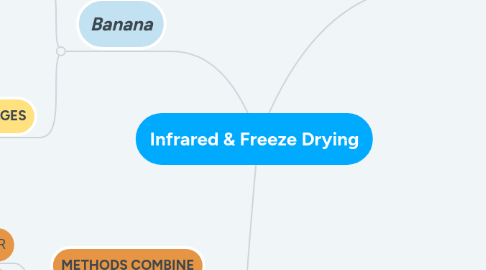
1. Banana
1.1. RESULTS
1.1.1. Regular freeze-dried
1.1.1.1. Uniform and small porous structure
1.1.1.2. No damage/ disruption of cellular walls at heated surface
1.1.2. IR pretreated
1.1.2.1. 20% weight reduction
1.1.2.1.1. Large pores existed in center region due to formation of water vapor
1.1.2.1.2. Pores collapsed when further dried to 40%
1.2. ADVANTAGES
1.2.1. IR dried slices had higher drying rate compared to hot air pre-dried sample during freeze-drying
1.2.1.1. To achieve 40% weight reduction
1.2.1.1.1. Hot air drying
1.2.1.1.2. Catalytic-IR drying:
1.2.2. Ascorbic/ Citric acid dipping
1.2.2.1. Improve product colour
1.2.2.2. Reduced freeze-drying time
2. Strawberries
2.1. METHODS COMBINE
2.1.1. Catalytic-IR
2.1.2. Freeze-drying
2.1.2.1. New processing method
2.1.2.1.1. High quality crispy strawberries pieces at less costly
2.2. RESULTS
2.2.1. More desirable colour
2.2.2. Higher crispness
2.2.3. More shrinkage
2.3. ADVANTAGES
2.3.1. Lower rehydration ratio than freeze dried product
2.3.1.1. Required freeze time reduced to 42%
2.3.1.1.1. Indicating large energy saving in producing high crispness strawberry pieces
3. Sweet Potato & Yam
3.1. METHOD
3.1.1. Response surface methodology optimized
3.1.1.1. Drying temperature
3.1.1.2. Distance between sample Far-IR heater
3.1.1.3. Thickness of the sample
3.1.2. Keep in view
3.1.2.1. Drying time
3.1.2.2. Re-hydration ratio
3.1.2.3. Total colour difference
3.2. RESULTS
3.2.1. Described using
3.2.1.1. Exponential
3.2.1.2. Page
3.2.1.3. Approx. diffusion models
3.2.2. Optimum drying established
3.2.2.1. 50mm distance from far-IR plate
3.2.2.2. Temperature 34-37 degree celcius
3.2.2.3. Slices thickness 7-8mm
3.3. ADVANTAGES
3.3.1. Reduced the processing time by half
